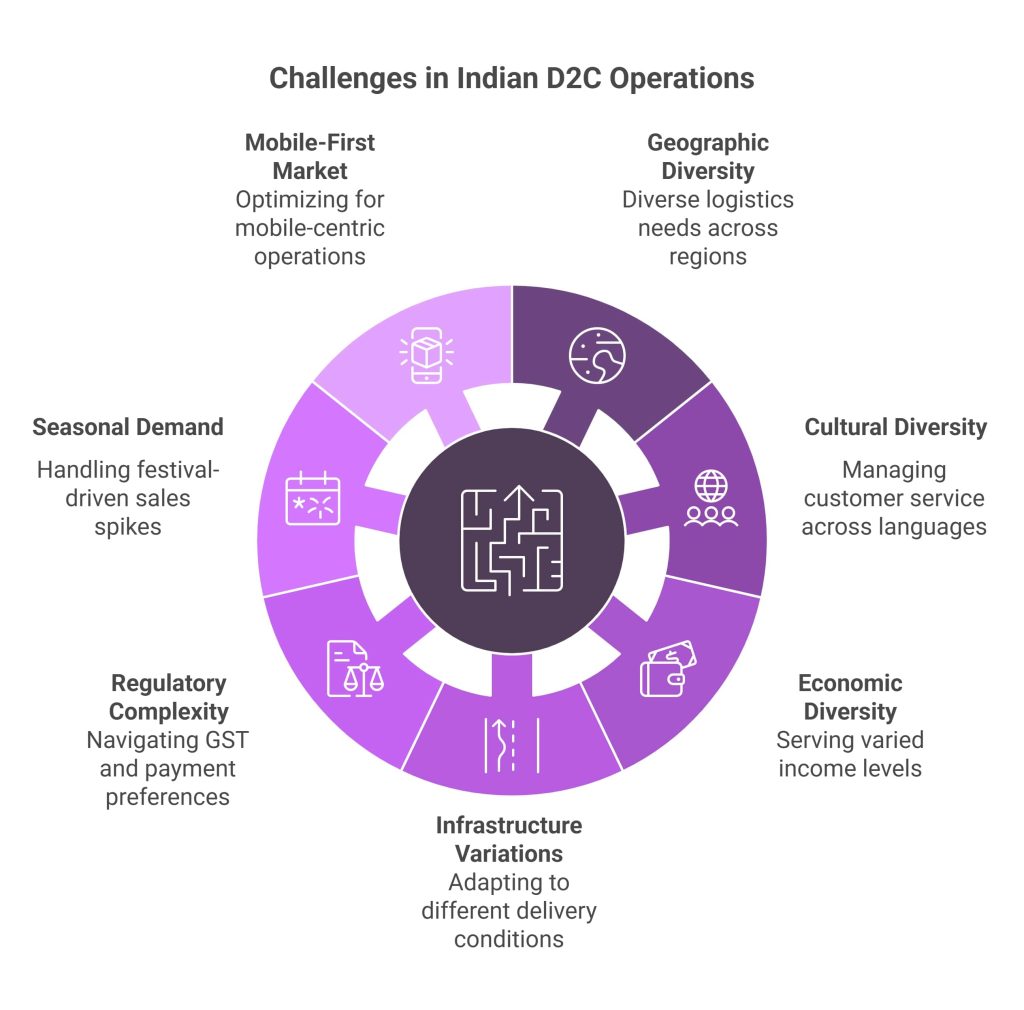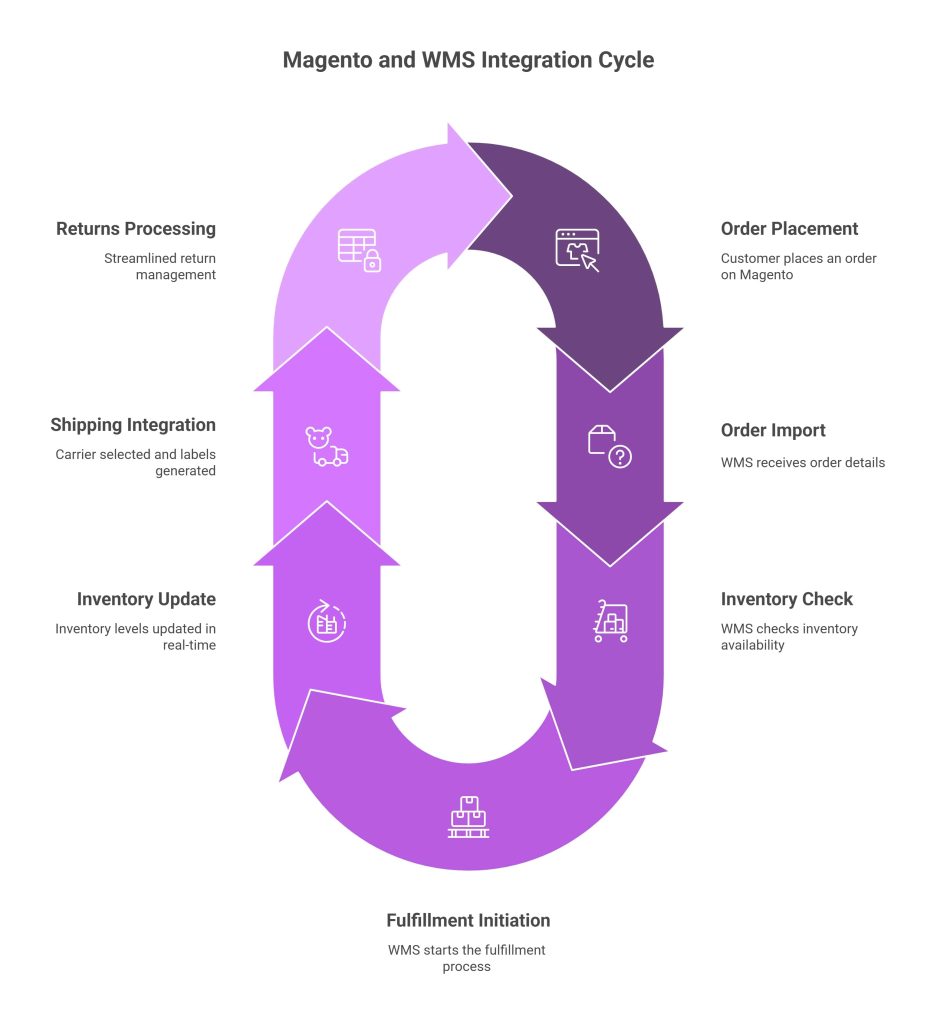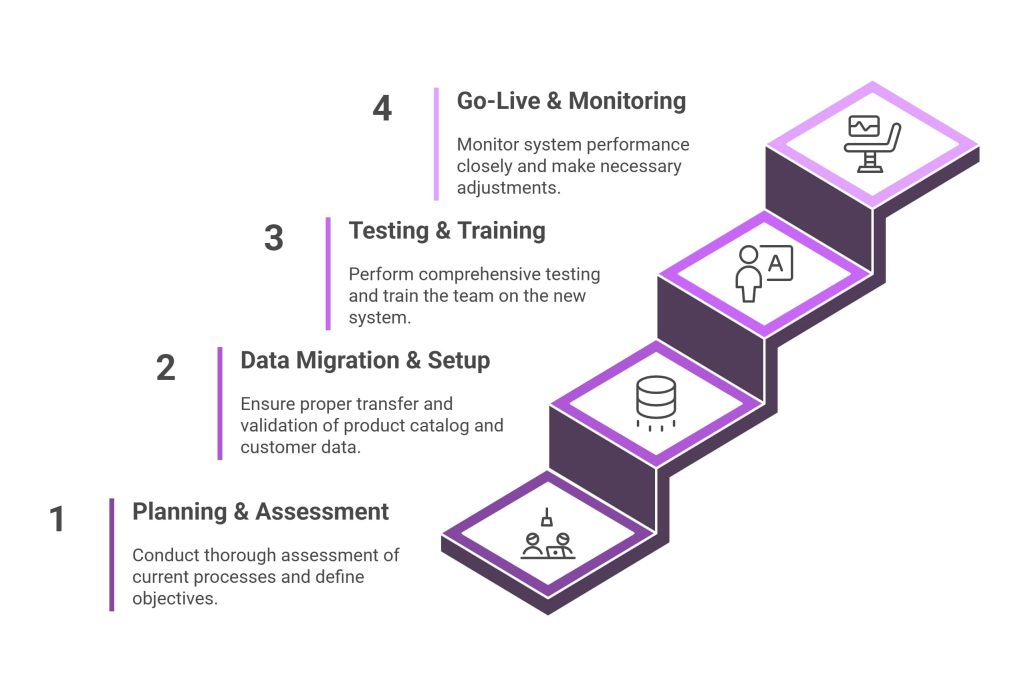Picture this: You’re running a thriving D2C brand in India, orders are pouring in from Mumbai to Manipur, but your warehouse feels like controlled chaos. Sound familiar? If you’re nodding your head, you’re not alone. WMS for Magento in India has become the lifeline for countless D2C businesses struggling to keep up with inventory management, order fulfillment, and the unique challenges of serving India’s diverse market.
The Indian D2C market is exploding, with over 560 million internet users and tremendous growth potential ahead.
Brands like Nykaa, Boat, and Mamaearth are setting new benchmarks, but behind every successful D2C story lies a robust warehouse management system seamlessly integrated with their e-commerce platform. That’s where Magento warehouse management system India comes into play.

What makes the Indian market particularly fascinating is its complexity – we’re talking about a country with over 600 million mobile users spread across diverse languages, cultures, and economic backgrounds. This presents both incredible opportunities and unique operational challenges that require specialized warehouse management system for Magento India solutions.
In this comprehensive guide, we’ll dive deep into everything you need to know about implementing a warehouse management system for Magento India, specifically tailored for D2C commerce. Whether you’re a startup founder in Bangalore or an established brand in Delhi looking to scale across tier-2 cities, this article will help you understand how the right WMS can transform your operations.
What is WMS for Magento in India?
A Magento WMS for D2C commerce is essentially the brain of your warehouse operations, integrated directly with your Magento store. Think of it as your warehouse’s personal assistant that never sleeps, never forgets, and never makes mistakes (well, almost never).
In the Indian context, where D2C brands face unique challenges like serving customers from metros to small towns, managing complex GST structures, and dealing with diverse shipping requirements, a specialized magento inventory management India solution becomes crucial. These systems handle everything from inventory tracking to order processing, ensuring your customers get their products on time, whether they’re ordering from a tech-savvy millennial in Gurgaon or a first-time online shopper in Jaipur.
The Indian Digital Landscape Reality
What makes India unique is that most Indian internet users regard digital content in their native language as more trustworthy than English content. This means your WMS needs to support multilingual interfaces and documentation.
With voice search growing at 270% annually in India, future-ready WMS solutions are already preparing for voice-enabled warehouse operations.
The beauty of integrating a WMS with Magento lies in its ability to automate processes that would otherwise consume hours of manual work. From real-time inventory tracking Magento to automated reorder points, these systems are designed to make your life easier while boosting your bottom line – crucial when you’re competing in a market where mobile-first thinking dominates.
Why D2C Brands Need Magento Warehouse Management System India
Let’s be honest – running a D2C business in India without proper warehouse management is like trying to navigate Mumbai traffic without GPS. Sure, you might eventually reach your destination, but the journey will be chaotic, stressful, and inefficient.
Indian D2C brands face operational challenges that make magento warehouse integration india not just beneficial, but essential:
Geographic and Cultural Complexity:
- Regional diversity: Shipping from Bangalore to Kashmir involves different logistics than Mumbai to Chennai
- Language barriers: Customer service and returns processing across 19,500+ languages, though focusing on Hindi, Bengali, Marathi, Telugu, and Tamil covers most bases
- Economic diversity: Serving customers from metros earning lakhs to small-town buyers making their first online purchase
- Infrastructure variations: Delivery challenges in tier-3 cities versus metro areas

Regulatory and Business Environment:
- GST complexity: Different tax structures across states and product categories
- Payment preferences: Managing COD-heavy markets alongside digital payment adoption
- Return patterns: Higher return rates due to size/fit issues in fashion and varying quality expectations
- Seasonal demand: Festival-driven sales spikes requiring agile inventory management
Mobile-First Market Reality:
With mobile internet usage well ahead of the global average, your WMS must support mobile-optimized interfaces for warehouse staff and integrate seamlessly with mobile-focused customer experiences.
Why Magento for the Indian Market?
Magento has established itself as a preferred platform for D2C brands in India because of its flexibility and scalability. When combined with a robust magento logistics solutions india framework, it becomes a powerhouse for e-commerce operations tailored to Indian market needs.
The platform’s open-source nature allows for extensive customization – crucial for brands that need features like multi-language support, regional payment gateway integrations, and GST-compliant invoicing. Moreover, magento warehouse software for startups can be scaled up as the business grows, ensuring you don’t outgrow your system as you expand from serving Delhi-NCR to pan-India operations.
Best WMS for Magento 2 India – Top Solutions
Choosing the best WMS for Magento 2 India can feel overwhelming, but don’t worry – we’ve analyzed solutions based on their performance in the unique Indian market context. Here are the top solutions that have proven their worth in the Indian D2C landscape:
India-Focused WMS Solutions:
1. Unicommerce: Purpose-built for the Indian market, this solution excels in magento order fulfillment solutions india and has extensive integration with local logistics partners like Delhivery, Blue Dart, and DTDC. It handles COD reconciliation, multi-state GST compliance, and regional language support.
2. Orderhive: This India-based solution understands local market nuances and offers strong magento shipping automation india features. It’s particularly good at managing the complexity of Indian addressing systems and pin code-based delivery optimization.
3. Browntape: Strong in handling multi-channel inventory management with good magento warehouse analytics capabilities, especially useful for brands selling across multiple platforms in India.
Global Solutions with Indian Adaptations:
4. Zoho Inventory: A cost-effective solution that offers good magento ERP integration india features with strong GST compliance capabilities. It’s particularly popular among startups and medium-sized businesses due to its affordable pricing and local support.
5. QuickBooks Commerce: (formaly TradeGecko) Known for its user-friendly interface and robust magento inventory automation for d2c capabilities. While global, it has been adapted well for Indian tax and compliance requirements.
6. Cin7 Omni: This comprehensive solution offers excellent magento warehouse analytics and integrates well with Indian payment gateways. It’s particularly strong in multi-warehouse support magento with good support for regional inventory distribution strategies.
Best of All: OmneelabWMS
7. OmneelabWMS: OmneelabWMS stands out as the ultimate warehouse management system for Magento India, blending deep local market expertise with advanced global technology. This all-in-one platform delivers seamless magento inventory automation for D2C operations, AI-powered analytics, and native magento order fulfillment integration—ensuring brands never have to compromise between innovation and regional needs. With proven results in order accuracy and fulfillment speed, OmneelabWMS is the definitive choice for Indian D2C brands aiming to scale efficiently and reliably.
Key Advantages:
- Comprehensive logistics integration with major Indian shipping partners including express delivery and COD solutions
- Advanced warehouse automation tools with real-time inventory tracking and AI-powered demand forecasting
- Multi-state GST compliance with automated tax calculations and regulatory reporting capabilities
- Seamless API integration with Magento 2.4+ ensuring 99.9% uptime and zero-downtime deployment Cost-effective pricing structure with transparent fees and scalable plans that grow with your business
- 24/7 India-based technical support with dedicated implementation specialists and ongoing optimization consultancy
How Does a WMS Integrate with Magento for D2C Brands?
Understanding magento d2c fulfillment integration is crucial for making an informed decision. The integration typically happens through APIs that connect your Magento store with the WMS, creating a seamless flow of information.
The Integration Process
The magic happens in real-time data synchronization. When a customer places an order on your Magento store, the WMS immediately receives the order details, checks inventory availability, and initiates the fulfillment process. This magento e-commerce logistics integration ensures that your inventory levels are always accurate across all platforms.
Key Integration Points:
- Order Management: Automatic order import from Magento to WMS
- Inventory Sync: Real-time inventory updates between systems
- Shipping Integration: Automatic carrier selection and label generation
- Returns Processing: Streamlined return management workflow
The beauty of modern magento warehouse automation tools is that this entire process happens behind the scenes, allowing your team to focus on growing the business rather than managing mundane operational tasks.

What are the Benefits of Using a WMS with Magento for D2C Commerce?
The benefits of implementing magento supply chain management in India extend far beyond simple inventory tracking. Let’s explore how these systems can transform your D2C operations:
Operational Efficiency
First and foremost, a WMS eliminates the guesswork from warehouse operations. Magento pick and pack automation ensures that the right products are picked, packed, and shipped efficiently. This reduces errors, speeds up fulfillment, and ultimately leads to happier customers.
Cost Reduction
By optimizing warehouse operations, you can significantly reduce labor costs and minimize errors that lead to returns and refunds. Magento warehouse scalability ensures that your operational costs don’t skyrocket as you grow.
Customer Satisfaction
In today’s competitive landscape, customer experience is everything. With accurate inventory information and faster fulfillment, you can provide your customers with reliable delivery estimates and exceptional service.
Data-Driven Decisions
Modern WMS solutions provide comprehensive analytics that help you make informed decisions about inventory levels, demand forecasting, and operational improvements.
Compliance and Accuracy
For Indian D2C brands, managing GST and other regulatory requirements is crucial. A good WMS ensures compliance while maintaining accuracy in all transactions.
Magento Inventory Automation for D2C – Key Features
When evaluating magento inventory automation for d2c solutions, certain features are non-negotiable for Indian businesses:
Real-Time Inventory Tracking
Real-time inventory tracking Magento capability ensures that your online store never shows products as available when they’re actually out of stock. This prevents overselling and the associated customer disappointment.
Automated Reordering
Smart reordering algorithms analyze sales patterns and automatically generate purchase orders when inventory levels hit predetermined thresholds. This prevents stockouts without tying up excessive capital in inventory.
Multi-Location Management
As your D2C brand grows, you’ll likely need to manage inventory across multiple locations. Multi-warehouse support Magento features allow you to optimize inventory placement and reduce shipping costs.
Batch and Serial Number Tracking
For certain product categories, especially in sectors like pharmaceuticals or electronics, FMCG batch and serial number tracking is essential for compliance and quality control.
Demand Forecasting
Advanced WMS solutions use historical data and market trends to predict future demand, helping you make smarter inventory decisions.
Can Magento Handle Multi-warehouse Management in India?
This is one of the most frequently asked questions by growing D2C brands. The short answer is yes – multi-warehouse support Magento is not only possible but highly effective when implemented correctly.
The Multi-Warehouse Advantage
Managing multiple warehouses allows D2C brands to:
- Reduce shipping costs by storing inventory closer to customers
- Improve delivery times across different regions
- Distribute risk across multiple locations
- Better serve diverse market segments
Implementation Strategies
Successful multi-warehouse management requires careful planning. You need to consider factors like demand patterns in different regions, shipping costs, and inventory allocation strategies.
Technology Requirements
The right magento warehouse automation tools make multi-warehouse management seamless. These systems can automatically determine the optimal fulfillment location for each order based on factors like proximity, inventory availability, and shipping costs.
How to Automate Order Fulfillment in Magento for Indian E-commerce?
Automation is the key to scaling your D2C operations efficiently. Here’s how to implement comprehensive magento order fulfillment solutions india:
Order Processing Automation
The moment an order is placed, your system should automatically:
- Validate payment and shipping information
- Check inventory availability
- Generate picking lists
- Route orders to the appropriate fulfillment center
Picking and Packing Optimization
Modern WMS solutions use algorithms to optimize picking routes, reducing the time workers spend walking through the warehouse. Magento pick and pack automation can reduce fulfillment time by up to 40%.
Shipping Automation
Integration with magento shipping partners india allows for automatic last mile carrier selection based on cost, delivery time, and service level requirements. The system can automatically generate shipping labels and tracking information.
Quality Control Integration
Automated quality control checkpoints ensure that the right products are shipped in good condition, reducing returns and improving customer satisfaction.
Which WMS Solutions are Compatible with Magento 2 in India?
Compatibility is crucial when selecting a WMS for your Magento store. Here are the key factors to consider:
Native Integration vs. Third-Party Connectors
Some WMS solutions offer native Magento integration, while others require third-party connectors. Native integrations are generally more reliable and offer better performance.
API Capabilities
Robust API capabilities ensure smooth data flow between systems. Look for solutions that offer real-time synchronization and comprehensive error handling.
Indian Market Specifics
Choose solutions that understand Indian business requirements, including GST compliance, local shipping partners, and payment gateway integrations.
Scalability Considerations
Your chosen solution should be able to handle your current volume while scaling up as your business grows.
Implementation Best Practices for Magento WMS Integration
Successful implementation of magento ERP integration india requires careful planning and execution. Here are the best practices that can make or break your project:
Phase 1: Planning and Assessment
Before diving into implementation, conduct a thorough assessment of your current processes. Identify pain points, define success metrics, and establish clear objectives.
Phase 2: Data Migration and Setup
Data migration is often the most challenging part of implementation. Ensure that your product catalog, customer information, and historical data are properly transferred and validated.

Phase 3: Testing and Training
Comprehensive testing is crucial before going live. Train your team on the new system and establish standard operating procedures.
Phase 4: Go-Live and Monitoring
Monitor system performance closely during the initial weeks after go-live. Be prepared to make adjustments as needed.
Future of Magento WMS in India
The landscape of magento warehouse management system india is evolving rapidly. Here’s what the future holds:
AI and Machine Learning Integration
Future WMS solutions will leverage AI for better demand forecasting, automated decision-making, and predictive maintenance.
IoT Integration
Internet of Things (IoT) devices will provide real-time visibility into warehouse operations, from temperature monitoring to equipment performance tracking.
Blockchain for Transparency
Blockchain technology may revolutionize supply chain transparency, particularly important for D2C brands focusing on authenticity and sustainability.
Voice and Robotics
Voice-directed picking and robotic fulfillment are becoming more accessible, even for smaller D2C operations.
Conclusion
Implementing the right WMS for Magento in India can be the difference between struggling with operational chaos and building a scalable, efficient D2C business. As we’ve explored throughout this guide, the benefits extend far beyond simple inventory management – from improved customer satisfaction to data-driven decision making.
The key is choosing a solution that not only meets your current needs but can grow with your business. Whether you’re a startup looking for magento warehouse software for startups or an established brand seeking to optimize operations, the right WMS integration can transform your business.
Remember, the goal isn’t just to manage your warehouse – it’s to create a competitive advantage that allows you to deliver exceptional customer experiences while maintaining healthy profit margins.
Ready to transform your D2C operations? Start by assessing your current warehouse management processes and identifying the biggest pain points. Then, evaluate WMS solutions based on your specific needs, budget, and growth plans. The investment in the right system today will pay dividends as your business scales.
Frequently Asked Questions
The cost varies significantly based on your business size and requirements. Basic solutions can start from ₹15,000-25,000 per month, while enterprise-level systems may cost ₹1-5 lakhs per month. Consider factors like setup fees, training costs, and ongoing support when budgeting. Most providers offer scalable pricing based on order volume or number of users.
Typical integration timelines range from 4-12 weeks, depending on the complexity of your operations and customization requirements. Simple integrations with standard products can be completed in 4-6 weeks, while complex multi-warehouse setups with custom features may take 8-12 weeks. Proper planning and data preparation can significantly reduce implementation time.
Absolutely! Many WMS providers offer starter plans specifically designed for small businesses and startups. These solutions can help you establish proper inventory management practices from the beginning, preventing operational issues as you scale. Look for cloud-based solutions with flexible pricing and easy setup processes.
The main challenges include GST compliance integration, managing diverse shipping requirements across different states, integrating with local payment gateways, and training staff on new systems. Additionally, ensuring reliable internet connectivity and managing seasonal demand fluctuations can be challenging. Working with providers who understand the Indian market can help address these issues.
WMS improves inventory accuracy through real-time tracking, barcode scanning, cycle counting automation, and systematic audit trails. These systems eliminate manual data entry errors and provide complete visibility into inventory movements. Most businesses see inventory accuracy improvements from 80-85% to 99%+ after implementing a proper WMS solution.
People also read:
- WMS for WooCommerce
- WMS for BigCommerce
- Last Mile Delivery Stations in India
- WMS for Last Mile in India
- Small Business Barcoding
- Demand-driven Replenishment Practices for Retailers
- Guide to Managing Perishable Inventory
- What Is a Bill of Materials (BOM)? Expert Guide & Tips
- Inventory Management with Barcode Technology
- Common Inventory Management Challenges

Kapil Pathak is a Senior Digital Marketing Executive with over four years of experience specializing in the logistics and supply chain industry. His expertise spans digital strategy, search engine optimization (SEO), search engine marketing (SEM), and multi-channel campaign management. He has a proven track record of developing initiatives that increase brand visibility, generate qualified leads, and drive growth for D2C & B2B technology companies.